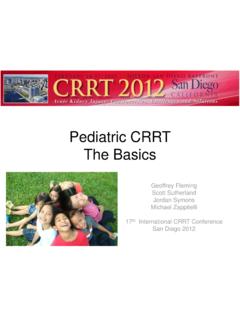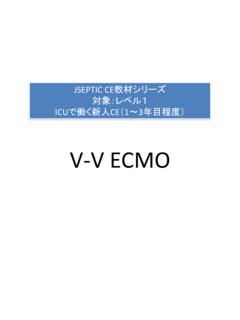Transcription of CRRT and ECMO Techniques and Outcomes from …
1 CRRT in ECMO Patients: Techniques and Outcomes from the ELSO Registry David Askenazi MD MS Associate Professor of Pediatrics 17th Annual CRRT Meeting Objectives Discuss how RRT is performed in critically ill patients on ECMO Review the incidence and Outcomes in ECMO patients with AKI / RRT. Assess if AKI and RRT provision are independently associated with mortality Extracorporeal Membreane Oxygenation (ECMO) Indications for ECMO Severe acute heart or lung failure Expected mortality risk 80% despite optimal conventional therapy ECMO initiation usually improves hemodynamic status ELSO Registry General Guidelines. April 2009 ECMO initiation may predispose patients to AKI ECMO initiation causes Increased inflammatory response 1 Hypercoaguable state 2 Hemolysis/ Hemoglobinuria 3 et al.
2 Pediatric Research August 2010 A. Seminars in Hematology 1995 J. and Bartlett R. Perfusion 2011 Not surprising that these patients develop AKI Technical Considerations How do you do it? Access ECMO and RRT System .Adapted from Hoover N et al. Intensive Care Medicine, 2008. CRRT machines with ECMO Access Pressure on CRRT may be positive Some Dialysis Machines can allow for alarms to be adjusted during ECMO Clamps can be used to avoid these alarms Increases Hemolysis Circuit prime Can use either a saline prime or blood prime Careful with heparin rinse ECMO and In-Line Hemofilter System .Adapted from Hoover N et al. Intensive Care Medicine, 2008. R ECMO and In-Line Hemofilter System SCUF CVVH .Adapted from Hoover N et al. Intensive Care Medicine, 2008. R ECMO and In-Line Hemofilter System D CVVHD.
3 Adapted from Hoover N et al. Intensive Care Medicine, 2008. R ECMO and In-Line Hemofilter System D CVVHDF .Adapted from Hoover N et al. Intensive Care Medicine, 2008. CRRT on ECMO using Homemade In-Line system Must return dialyzed blood pre BLADDER IV infusion pumps control ultrafiltrate Up to % inaccuracies in some studies IV pumps are not engineered to maintain accuracy at higher pressures Ultrafiltration Error Rate Increases with Increasing Flow/Pressure Differential Sucosky, Paden et al., JMD 2008 NO RRTIN- LINERRT MachineunknownWhat type of modality is used Flemming G, et al. abstract CRRT 2012 KIDMO Study Group SCUFCVVHCVVHDCVVHDFM odality with RRT machine Flemming G, et al. abstract CRRT 2012 KIDMO Study Group SCUFCVVHCVVHDCVVHDFM odality w/ In-Line Hemofilter Flemming G, et al.
4 Abstract CRRT 2012 KIDMO Study Group Differences between RRT methods In Line Hemofilter CRRT machine Ultrafiltration control IV pump controlled CRRT machine controlled Metabolic Control NOT if only using SCUF YES ECMO Flow Blood Shunt -decrease ECMO flow -decreased PaO2 NO systemic changes Complexity Less People More People Epidemiology of AKI in ECMO patients How often does AKI happen in ECMO patients? Single Center Pediatric Data Neonates with congenital diaphragmatic hernia (CDH) 1 84% Children with Cardiac Indications 2 71% 1. Gadepalli et al. Pediatric Surgery July 2010 2. Smith et. al ASAIO 2009 Single Center Adult Data NO 22% R 15% I 39% F 24% 22 Retrospective analysis of 46 adults on ECMO using RIFLE 78% of patients had AKI Lin, et al. NDT. 2006 RIFLE in adults on ECMO Lin, et al.
5 NDT. 2006 Survival 8/10 (80%) 3/7 (57%) 5/18 (28%) 0/11 (0%) NO AKI 19% R 17% I 28% F 36% AKI by RIFLE at 48 hrs No AKI 15% 1 19% 2 18% 3 48% AKI by AKIN at 48 hrs Yan X. et al.; Eur J Cardthorac Surg 2010 81% incidence of AKI 85% incidence of AKI Adults on ECMO Post-Cardiotomy Stage F vs. NO AKI Independent OR for death = (95% CI = ) p = Stage 3 vs NO AKI Independent OR for Death = (95% CI = ) p = AKI by RIFLE at 48 hours AKI by AKIN at 48 hours Yan X. et al.; Eur J Cardthorac Surg 2010 Adults on ECMO Post-Cardiotomy 0102030405060708090100 ECMO onlyN = 224 ECMO + CRRT N= 154 NeonatalPaden et al. PCCM March 2011 RRT provision is associated with poor survival 0102030405060708090100 ECMO onlyN = 224 ECMO + CRRT N= 154 NeonatalPediatricPaden et al.
6 PCCM March 2011 RRT provision is associated with poor survival ELSO Registry 1985- 2008: Pediatric Cardiac Indications 01020304050600-30 days1-12 months1-16 years> 16 yearsNo dialysisDialysis28 Are AKI / RRT independently associated with mortality in ECMO patients? Association Causality Extracorporeal Life Support Organization (ELSO) Registry ELSO Registry Composed of nearly all ECMO cases worldwide Over 40,000 cases 2 separate registries cadiac and noncardiac ELSO Registry 1998 - 2008 Neonates N =7941 children Pediatrics ELSO Registry 1998 - 2008 N = 1962 children Adults ELSO Registry 1998 - 2008 N = 1011 adults outcome Survival vs. Non-survival Primary exposures of interest AKI Complication code of SCr mg/dl or ICD-9 code of Acute renal failure Dialysis CPT codes used Variables Analyzed Askenazi et al.
7 Pediatric Critical Care Medicine 2011 Demographics Physiologic Data before ECMO Physiologic Data during ECMO Therapy characteristics Co-morbid conditions Complications Interventions Potential Confounders Analyzed Askenazi et al. Pediatric CCM 2011 ELSO Registry - Neonates 74%3%5%18%NeitherAKIBothRRT Askenazi et al. Pediatric CCM 2011 Pediatric ELSO registry 54%26%4%16%NeitherRRT SCr > mg/dlBothAskenazi et al. Pediatric Critical Care Medicine 2011 Adult Non-Cardiac ELSO Registry AKI 7% Both 27% RRT 15% Neither 51% Survival in AKI/ RRT subjects 020406080100 NeitherRRTAKIBothAskenazi et al. Pediatric Critical Care Medicine 2011 020406080100 NeitherRRTAKIBothNeonatesChildrenAdultsA skenazi et al. Pediatric Critical Care Medicine 2011 Survival in AKI/ RRT subjects Odds of Death for AKI / RRT from ELSO Registry Crude OR Adjusted OR p-value Neonate AKI < RRT < Children AKI < RRT < Adult AKI < RRT < Askenazi et al.
8 Pediatric Critical Care Medicine 2011 AKI / RRT are Independently Associated with Adult Mortality Propensity Score Matched Case-Control Acute Kidney Injury Odds Ratio (95% CI) p-value Crude ( ) p < Propensity score matched ( ) p < Renal Replacement Therapy Odds Ratio (95% CI) Crude ( ) p < Propensity score matched ( ) p < Acute Kidney Injury Odds Ratio (95% CI) p-value Crude ( ) p < Propensity score matched ( ) p < Renal Replacement Therapy Odds Ratio (95% CI) p-value Crude ( ) p < Propensity score matched ( ) p < Summary ECMO patients can receive RRT on ECMO CRRT machine in series In-line hemofilter Watch Ultrafiltration carefully ! Summary ECMO patients can receive RRT on ECMO Acute Kidney Injury is extremely common in ECMO patients Those with AKI and those who receive RRT have worse Outcomes independent of important confounders Improved understanding of how best to support ECMO patients with AKI is likely to improve Outcomes







